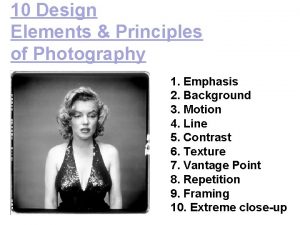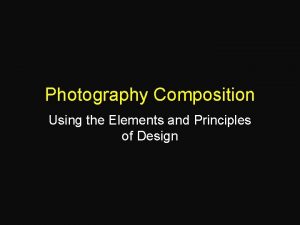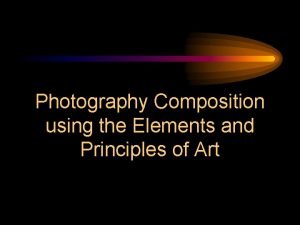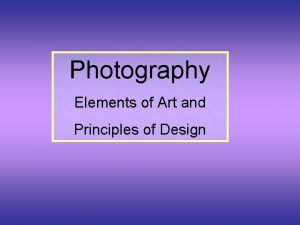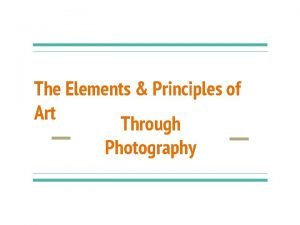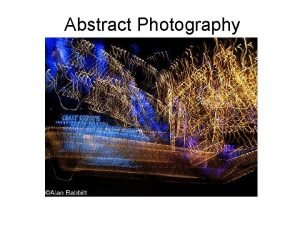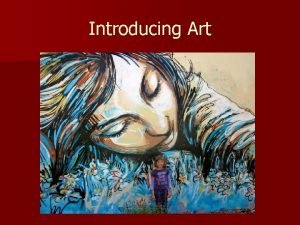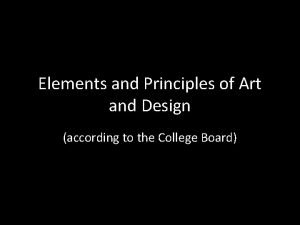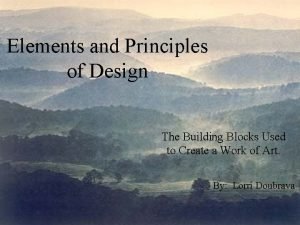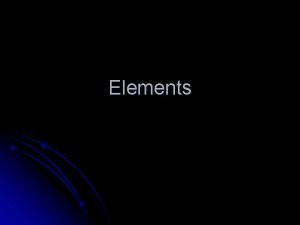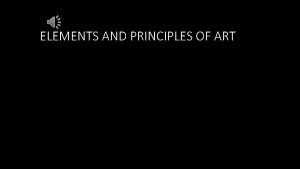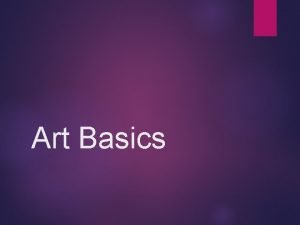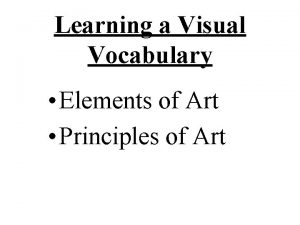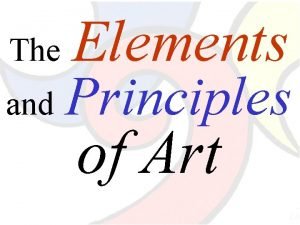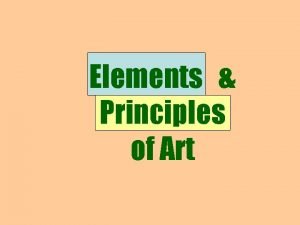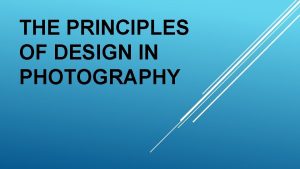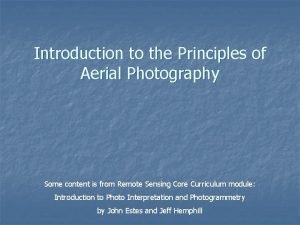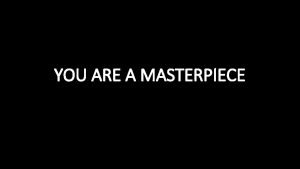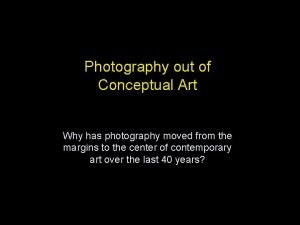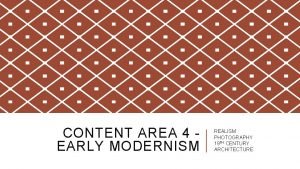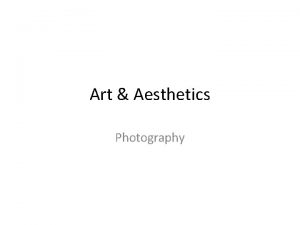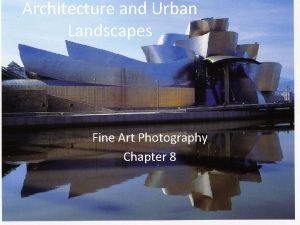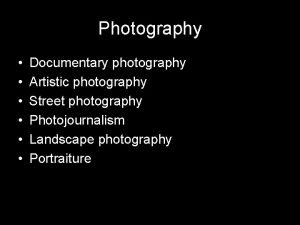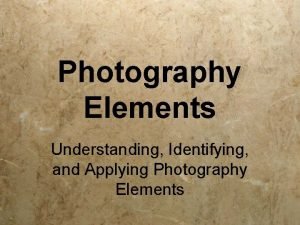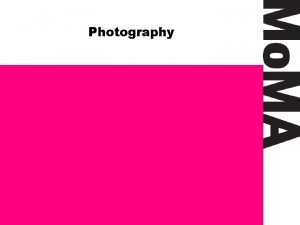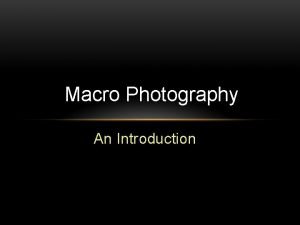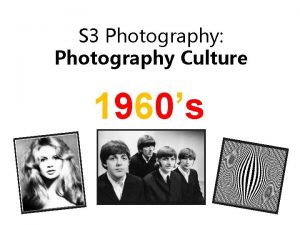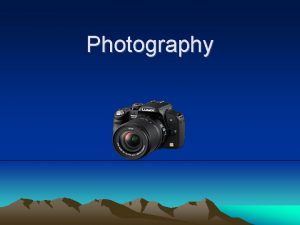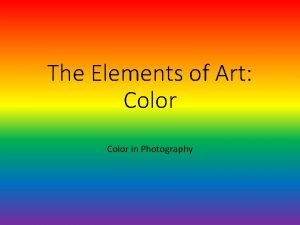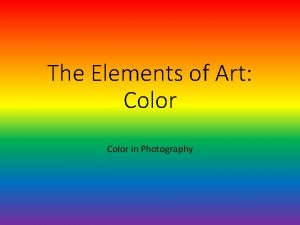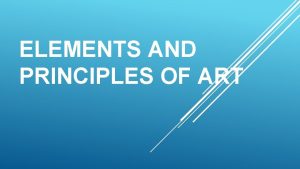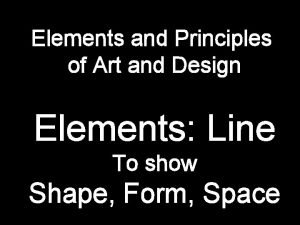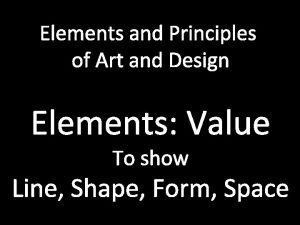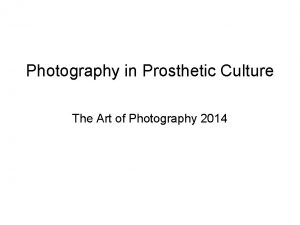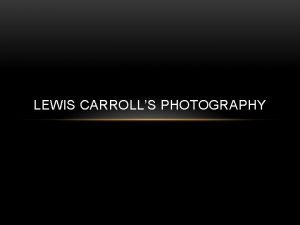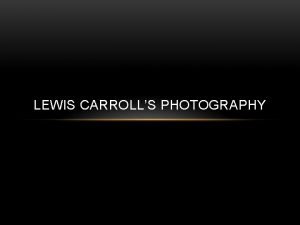Photography The Elements of Art and Principles of






























































- Slides: 62

Photography The Elements of Art and Principles of Design

Elements of Art The Basic Building Blocks • • Line Shape Form Space Value Texture Color

LINE • A mark made by a moving point. • Has greater length than width. • Directs the eye – horizontal, vertical, diagonal, curvy, zig-zag, etc. • Can be actual obvious lines or the borders or edges of shapes. • Line can be real or implied

LINE

LINE

LINE Andy Goldsworthy

Shape is an enclosed space defined by other elements of art. Shape is 2 -Dimensional Shape can be: Geometric: Angular, man-made concept: circle, triangle, square Organic: curvilinear - found in nature Fernana Leger, The City Matisse, from the series “Jazz”

SHAPE

FORM

SPACE • Positive space (occupied space) – the area the objects/subject takes up. • Negative space (unoccupied space) – the area around, under, through and between. • Gives the photo a 3 -dimensional feeling - Depth of Field • Foreground (closest) bottom • Middle ground – middle • Background (farthest) – top • Can be open, crowded, near, far, etc.

Positive and Negative Space

Space Positive space is filled by a shape or form. Negative space surrounds a shape or form.

SPACE • Atmospheric Perspective – Objects close = detailed, bright, sharp – Objects far = blurred, dull/gray • One point perspective – One vanishing point • 2 point perspective – 2 vanishing points

Atmospheric Perspective

SPACE

SPACE – linear perspective

VALUE • Black and White and all the Grays in between • Dark to Light • Can add drama and impact to composition. • Adds contrast • Creates 3 D form

Value An element of art that refers to luminance or luminosity – the lightness or darkness of a color. Value is an especially important element in works of art when color is absent. This is particularly likely with drawings, printmaking, and photographs Kathe Kollwitz, Self portrait

Value Chuck Close (made w/ thumbprints!) Edward Weston, Pepper (photograph)

VALUE

TEXTURE • The surface quality. • How an object feels, or how it looks like it feels. • Rough, smooth, bumpy, gooey, sharp, etc. • Adds interest! Sense of sight and sense of touch involved.

TEXTURE



COLOR • • Artistic term is HUE Need light to see color. Primary, Secondary, Intermediates. Use color schemes to enhance appeal or make an impact. • Cool • Warm • Color schemes: Analagous, Complementary, monochromatic

Warm Colors • Colors that are often described as being higher in temperature • Reds, oranges, yellows • Associated with fire and sun • Optically, appear to advance • Stimulating and passionate

Ex. Warm

Cool • Colors that are often described as being lower in temperature • Greens, Blues, and Violet • Associated with water, sky, and spring • Optically, they appear to recede • Calming and depressing

Ex. Cool

COLOR Analagous - Warm Monochromatic - Cool

COLOR

COLOR Complementary

Principles of Design The different arrangements – or compositions - of the ELEMENTS of design to create artistic, interesting, more visually powerful photographs.

Principles of Design • • Emphasis / Focal Point Balance Unity Contrast Movement/ Rhythm Pattern/Repetition Economy

BALANCE • Balance is a sense of stability in the body of work. Balance can be created by repeating same shapes and by creating a feeling of equal weight. • Symmetrical • Asymmetrical

BALANCE - Symmetrical

BALANCE - Asymmetrical

Symmetrical/Formal Balance Diane Arbus, Twins

BALANCE

BALANCE

VARIETY • Variety is all of the different elements in the photograph • Variety adds interest to the work and keeps the viewer’s eyes moving around the piece • You can achieve variety by using different elements in your work, such as: – Shapes – Textures – Colors – Values

VARIETY

VARIe. TEY – too much?

MOVEMENT / RHYTHM • Movement adds excitement to your work by showing action and directing the viewers eye throughout the picture plane. • Rhythm is a type of movement in an artistic composition. It is seen in repeating of shapes and colors. Alternating lights and darks also give a sense of rhythm.

MOVEMENT / RHYTHM

MOVEMENT

EMPHASIS / FOCAL POINT • Emphasis in a composition refers to developing points of interest to pull the viewer's eye to important parts of the body of the work. • Size, shape, color, placement, contrast, etc.

EMPHASIS / FOCAL POINT


PATTERN / REPETITION • An element that occurs over and over again in a composition. • Can repeat the element in a consistent pattern. • Can repeat the element in a variation of the pattern.

PATTERN / REPETITION

PATTERN / REPETITION


CONTRAST • Contrast refers to the opposites and differences in the work. • It creates interest, draws the viewer’s eye, and creates impact in the work. • You can create contrast through different elements in your work such as contrast in: – Shapes (organic vs. geometric) – Textures (rough vs. smooth) – Colors (complements) – Values (light vs. dark) -- Lines (straight vs. wavy, thin vs. thick) -- and many more

CONTRAST

CONTRAST

ECONOMY • Economy takes into account that less is more. • Using minimal visual information to convey the concept.

ECONOMY

UNITY • Unity is seen in a composition when all the parts equal a whole. • Ways to achieve unity: -Repeat elements: line, shapes, forms, colors. -Use a color scheme: analagous, complementary, triad, etc. -Overlap forms, lines, shapes.


UNITY

 Elements and principles of photography
Elements and principles of photography Elements shows the area used or unused in a composition
Elements shows the area used or unused in a composition Photography elements and principles
Photography elements and principles Elements and principles of photography
Elements and principles of photography Elements of art: color
Elements of art: color Elements of art photography
Elements of art photography Is abstract photography same as conceptual photography
Is abstract photography same as conceptual photography The actual surface feel of the simulated appearance
The actual surface feel of the simulated appearance A feeling of visual equality
A feeling of visual equality Elements and principles of art
Elements and principles of art Elements and principles of art
Elements and principles of art Principles of art rhythm
Principles of art rhythm Art basics
Art basics Basic elements of music play/theater
Basic elements of music play/theater Art vocabulary elements and principles
Art vocabulary elements and principles Drawing a face highlights what principle of design
Drawing a face highlights what principle of design Elements principles of art
Elements principles of art Elements principles of art
Elements principles of art Define rhythm in photography
Define rhythm in photography Central projection in aerial photographs
Central projection in aerial photographs Cindy sherman history
Cindy sherman history Victor burgin uk76
Victor burgin uk76 Nadar raising photography to the height of art
Nadar raising photography to the height of art Photography art definition
Photography art definition Fine art photography architecture
Fine art photography architecture Tone formal elements
Tone formal elements Hình ảnh bộ gõ cơ thể búng tay
Hình ảnh bộ gõ cơ thể búng tay Slidetodoc
Slidetodoc Bổ thể
Bổ thể Tỉ lệ cơ thể trẻ em
Tỉ lệ cơ thể trẻ em Voi kéo gỗ như thế nào
Voi kéo gỗ như thế nào Chụp tư thế worms-breton
Chụp tư thế worms-breton Alleluia hat len nguoi oi
Alleluia hat len nguoi oi Môn thể thao bắt đầu bằng từ đua
Môn thể thao bắt đầu bằng từ đua Thế nào là hệ số cao nhất
Thế nào là hệ số cao nhất Các châu lục và đại dương trên thế giới
Các châu lục và đại dương trên thế giới Công thức tiính động năng
Công thức tiính động năng Trời xanh đây là của chúng ta thể thơ
Trời xanh đây là của chúng ta thể thơ Cách giải mật thư tọa độ
Cách giải mật thư tọa độ Làm thế nào để 102-1=99
Làm thế nào để 102-1=99 Phản ứng thế ankan
Phản ứng thế ankan Các châu lục và đại dương trên thế giới
Các châu lục và đại dương trên thế giới Thơ thất ngôn tứ tuyệt đường luật
Thơ thất ngôn tứ tuyệt đường luật Quá trình desamine hóa có thể tạo ra
Quá trình desamine hóa có thể tạo ra Một số thể thơ truyền thống
Một số thể thơ truyền thống Cái miệng xinh xinh thế chỉ nói điều hay thôi
Cái miệng xinh xinh thế chỉ nói điều hay thôi Vẽ hình chiếu vuông góc của vật thể sau
Vẽ hình chiếu vuông góc của vật thể sau Thế nào là sự mỏi cơ
Thế nào là sự mỏi cơ đặc điểm cơ thể của người tối cổ
đặc điểm cơ thể của người tối cổ Ví dụ về giọng cùng tên
Ví dụ về giọng cùng tên Vẽ hình chiếu đứng bằng cạnh của vật thể
Vẽ hình chiếu đứng bằng cạnh của vật thể Phối cảnh
Phối cảnh Thẻ vin
Thẻ vin đại từ thay thế
đại từ thay thế điện thế nghỉ
điện thế nghỉ Tư thế ngồi viết
Tư thế ngồi viết Diễn thế sinh thái là
Diễn thế sinh thái là Các loại đột biến cấu trúc nhiễm sắc thể
Các loại đột biến cấu trúc nhiễm sắc thể Các số nguyên tố
Các số nguyên tố Tư thế ngồi viết
Tư thế ngồi viết Lời thề hippocrates
Lời thề hippocrates Thiếu nhi thế giới liên hoan
Thiếu nhi thế giới liên hoan ưu thế lai là gì
ưu thế lai là gì
